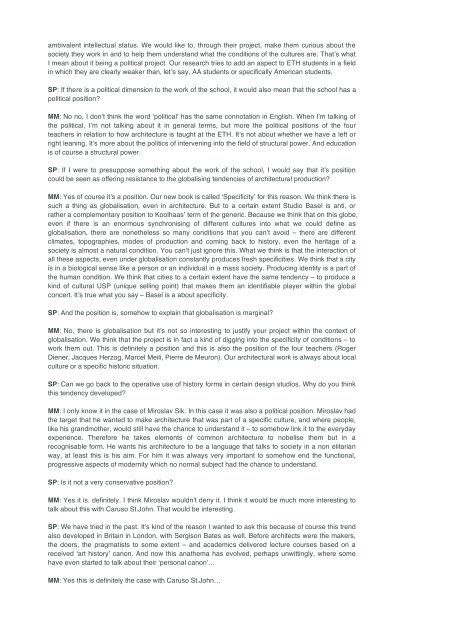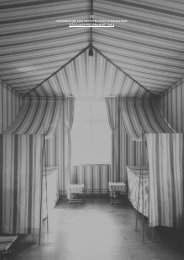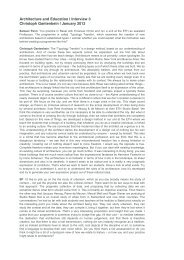Marcel Meili corrected - AE | Foundation for Architecture and ...
Marcel Meili corrected - AE | Foundation for Architecture and ...
Marcel Meili corrected - AE | Foundation for Architecture and ...
Create successful ePaper yourself
Turn your PDF publications into a flip-book with our unique Google optimized e-Paper software.
ambivalent intellectual status. We would like to, through their project, make them curious about the<br />
society they work in <strong>and</strong> to help them underst<strong>and</strong> what the conditions of the cultures are. Thatʼs what<br />
I mean about it being a political project. Our research tries to add an aspect to ETH students in a field<br />
in which they are clearly weaker than, letʼs say, AA students or specifically American students.<br />
SP: If there is a political dimension to the work of the school, it would also mean that the school has a<br />
political position?<br />
MM: No no, I donʼt think the word ʻpoliticalʼ has the same connotation in English. When Iʼm talking of<br />
the political, Iʼm not talking about it in general terms, but more the political positions of the four<br />
teachers in relation to how architecture is taught at the ETH. Itʼs not about whether we have a left or<br />
right leaning. Itʼs more about the politics of intervening into the field of structural power. And education<br />
is of course a structural power.<br />
SP: If I were to presuppose something about the work of the school, I would say that itʼs position<br />
could be seen as offering resistance to the globalising tendencies of architectural production?<br />
MM: Yes of course itʼs a position. Our new book is called ʻSpecificityʼ <strong>for</strong> this reason. We think there is<br />
such a thing as globalisation, even in architecture. But to a certain extent Studio Basel is anti, or<br />
rather a complementary position to Koolhaasʼ term of the generic. Because we think that on this globe,<br />
even if there is an enormous synchronising of different cultures into what we could define as<br />
globalisation, there are nonetheless so many conditions that you canʼt avoid – there are different<br />
climates, topographies, modes of production <strong>and</strong> coming back to history, even the heritage of a<br />
society is almost a natural condition. You canʼt just ignore this. What we think is that the interaction of<br />
all these aspects, even under globalisation constantly produces fresh specificities. We think that a city<br />
is in a biological sense like a person or an individual in a mass society. Producing identity is a part of<br />
the human condition. We think that cities to a certain extent have the same tendency – to produce a<br />
kind of cultural USP (unique selling point) that makes them an identifiable player within the global<br />
concert. Itʼs true what you say – Basel is a about specificity.<br />
SP: And the position is, somehow to explain that globalisation is marginal?<br />
MM: No, there is globalisation but itʼs not so interesting to justify your project within the context of<br />
globalisation. We think that the project is in fact a kind of digging into the specificity of conditions – to<br />
work them out. This is definitely a position <strong>and</strong> this is also the position of the four teachers (Roger<br />
Diener, Jacques Herzog, <strong>Marcel</strong> <strong>Meili</strong>, Pierre de Meuron). Our architectural work is always about local<br />
culture or a specific historic situation.<br />
SP: Can we go back to the operative use of history <strong>for</strong>ms in certain design studios. Why do you think<br />
this tendency developed?<br />
MM: I only know it in the case of Miroslav Sik. In this case it was also a political position. Miroslav had<br />
the target that he wanted to make architecture that was part of a specific culture, <strong>and</strong> where people,<br />
like his gr<strong>and</strong>mother, would still have the chance to underst<strong>and</strong> it – to somehow link it to the everyday<br />
experience. There<strong>for</strong>e he takes elements of common architecture to nobelise them but in a<br />
recognisable <strong>for</strong>m. He wants his architecture to be a language that talks to society in a non elitarian<br />
way, at least this is his aim. For him it was always very important to somehow end the functional,<br />
progressive aspects of modernity which no normal subject had the chance to underst<strong>and</strong>.<br />
SP: Is it not a very conservative position?<br />
MM: Yes it is. definitely. I think Miroslav wouldnʼt deny it. I think it would be much more interesting to<br />
talk about this with Caruso St.John. That would be interesting.<br />
SP: We have tried in the past. Itʼs kind of the reason I wanted to ask this because of course this trend<br />
also developed in Britain in London, with Sergison Bates as well. Be<strong>for</strong>e architects were the makers,<br />
the doers, the pragmatists to some extent – <strong>and</strong> academics delivered lecture courses based on a<br />
received ʻart historyʼ canon. And now this anathema has evolved, perhaps unwittingly, where some<br />
have even started to talk about their ʻpersonal canonʼ…<br />
MM: Yes this is definitely the case with Caruso St.John…




